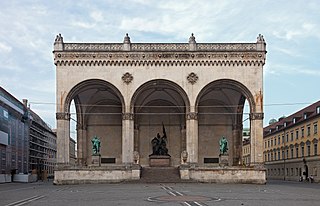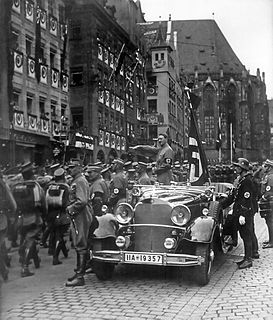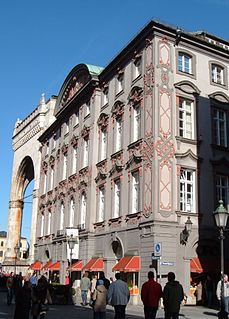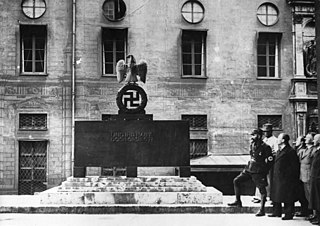
The Beer Hall Putsch, also known as the Munich Putsch, was a failed coup d'état by Nazi Party leader Adolf Hitler, Generalquartiermeister Erich Ludendorff and other Kampfbund leaders in Munich, Bavaria, on 8–9 November 1923, during the Weimar Republic. Approximately two thousand Nazis marched on the Feldherrnhalle, in the city centre, but were confronted by a police cordon, which resulted in the deaths of 16 Nazi Party members and four police officers.

Winifred Marjorie Wagner was the English-born wife of Siegfried Wagner, the son of Richard Wagner, and ran the Bayreuth Festival after her husband's death in 1930 until the end of World War II in 1945. She was a friend and supporter of Adolf Hitler, himself a Wagner enthusiast, and she and Hitler maintained a regular correspondence.

Johann Georg Elser was a German worker who planned and carried out an elaborate assassination attempt on Adolf Hitler and other high-ranking Nazi leaders on 8 November 1939 at the Bürgerbräukeller in Munich. Elser constructed and placed a bomb near the platform from which Hitler was to deliver a speech. It did not kill Hitler, who left earlier than expected, but it did kill 8 people and injured 62 others. Elser was held as a prisoner for more than five years until he was executed at the Dachau concentration camp less than a month before the surrender of Nazi Germany.

The Feldherrnhalle is a monumental loggia on the Odeonsplatz in Munich, Germany. Modelled after the Loggia dei Lanzi in Florence, it was commissioned in 1841 by King Ludwig I of Bavaria to honour the tradition of the Bavarian Army.

The Blutfahne, or Blood Flag, is a Nazi Party swastika flag that was carried during the attempted coup d’etat Beer Hall Putsch in Munich, Germany on 9 November 1923, during which it became soaked in the blood of one of the SA men who died. It subsequently became one of the most revered objects of the NSDAP. It was used in ceremonies in which new flags for party organizations were consecrated by the Blood Flag when touched by it.

The Blood Order, officially known as the "Decoration in Memory of 9 November 1923", was one of the most prestigious decorations in the Nazi Party (NSDAP). During March 1934, Hitler authorized the Blood Order to commemorate the 9 November 1923 coup attempt of the Nazi Party. The medal is silver, with the obverse bearing a depiction of an eagle grasping an oakleaf wreath. Inside the wreath is the date 9.Nov. and to the right is the inscription München 1923–1933. The reverse shows the entrance of the Feldherrnhalle in relief, and directly above is the angled swastika with sun rays in the background. Along the top edge is the inscription: UND IHR HABT DOCH GESIEGT.
The Bürgerbräukeller was a large beer hall in Munich, Germany. Opened in 1885, it was one of the largest beer halls of the Bürgerliches Brauhaus. After Bürgerliches merged with Löwenbräu in 1921, the hall was transferred to that company.

Ludwig Maximilian Erwin von Scheubner-Richter was a German political activist and an influential early member of the Nazi Party.

Königsplatz is a square in Munich, Germany. Built in the style of European Neoclassicism in the 19th century, it displays the Propyläen Gate and, facing each other, the Glyptothek and the Staatliche Antikensammlungen. The area around Königsplatz is home to the Kunstareal, Munich's gallery and museum quarter.

Heinz Pernet was a German military officer and Erich Ludendorff's stepson. He was a top figure in the Beer Hall Putsch of November 1923. He was among the nine men tried and convicted along with Adolf Hitler and Erich Ludendorff in 1924. He later became an SA-Brigadeführer.

The Brown House was the name given to the Munich mansion located between the Karolinenplatz and Königsplatz, known before as the Palais Barlow, which was purchased in 1930 for the Nazis. They converted the structure into the headquarters of the National Socialist German Workers' Party. Its name comes from early Nazi Party uniforms, which were brown. Many leading Nazis, including Adolf Hitler, maintained offices there throughout the party's existence. It was destroyed by Allied bombing raids during World War II.

The Palais Preysing is a late-Baroque mansion in Munich, southern Germany, which served as residence for the Counts of Preysing. To distinguish it from the nearby Palais Neuhaus-Preysing, it is also called the Elder Palais Preysing.

The neoclassical Brienner Straße in Munich is one of four royal avenues next to the Ludwigstraße, the Maximilianstraße and the Prinzregentenstraße. The boulevard was constructed from 1812 onwards, during the reigns of Maximilian I Joseph of Bavaria and his successor Ludwig I, in accordance with a plan by Karl von Fischer and Friedrich Ludwig von Sckell. The avenue is named after the Battle of Brienne.

The Odeonsplatz is a large square in central Munich which was developed in the early 19th century by Leo von Klenze and is at the southern end of the Ludwigstraße, developed at the same time. The square is named for the former concert hall, the Odeon, on its northwestern side. The name Odeonsplatz has come to be extended to the parvis (forecourt) of the Residenz, in front of the Theatine Church and terminated by the Feldherrnhalle, which lies to the south of it. The square was the scene of a fatal gun battle which ended the march on the Feldherrnhalle during the 1923 Beer Hall Putsch.

Ruins of the Reich is a documentary series that traces the rise and fall of the Third Reich through its architecture. Written and directed by film maker R. J. Adams, the film's "then and now" format focuses on the primary sites that played key roles from Hitler's rise to his final days in his Berlin bunker.

The Nordfriedhof, with 34,000 burial plots, is one of the largest cemeteries in Munich, Bavaria, Germany. It is situated in the suburb of Schwabing-Freimann. It was established by the former community of Schwabing in 1884. It is not to be confused with the Alter Nordfriedhof in Munich, which was set up only a short time previously within the then territory of the city of Munich.

Nikolaus Christoph von Halem was a German lawyer, businessman, and resistance fighter against Nazism.

Blutzeuge was a term used in Nazi Germany for members of the National Socialist German Workers' Party (NSDAP) and associated organizations considered to be martyrs. Blutzeuge was used in Nazi propaganda in the 1930s and 1940s depicting a hero cult of "fallen" Nazis who had been murdered by opponents in the political violence in Germany during the Weimar Republic and after the seizure of control in January 1933. An early Nazi usage of the term was Adolf Hitler's dedication at the start of Mein Kampf, which he dedicated to the sixteen NSDAP members killed in the 1923 Beer Hall Putsch.

Drückebergergasse is the popular name for Viscardigasse, a narrow, curbless pedestrian street, just over fifty metres long and paved with cobblestones throughout, in Munich, Germany. The street is officially named after the Swiss Baroque architect Giovanni Antonio Viscardi, but took its nickname from the 1930s, when locals could circumvent the nearby Nazi memorial to the martyrs of the 1923 Beer Hall Putsch, thus avoiding the requirement to render a Hitler salute to the guarded structure.
Friedrich Bernreuther was a German police officer. From July 1 to October 10, 1945, he was a public claimant in denazification cases for Ansbach, a Bavarian city in Germany.




















